






Dear seafarers,
There are several themes in this issue of Wavelength that relate to the importance of unity in the Company. Unity achieved by adopting the notion of family, for example, which has been seized upon by our Seafarers and shore staff alike, has been shown to strengthen bonds amongst colleagues and provide a common sense of purpose for everyone who has embraced the attitude of loving to work for our Company.
Another of the themes is commitment, which has led to a record number of promotions in a quarter. Moreover, there is diversity, especially with regard to perspective, as borne out in the Voices from the Fleet sections. No fewer than fifteen contributors, to whom I am extremely grateful, have put forward their points of view, expressed appreciation and gratitude as well as their insight into aspects of their jobs and lives they feel are worth communicating. It is also noteworthy that their willingness to express themselves ties in with the principle: “If you feel something, say something.”
Yet another theme is care. Caring for fleet vessels is highlighted by Ioannis Pantos, who has provided an update on improvements made to enhance safety and efficiency on board. Caring for our family’s mental health and enhancing safety are also given priority in engaging contributions by Chara Markatzinou and Elli Moretti
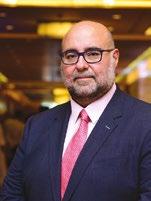
Dear seafarers and shore staff,
Another year has come to an end. It has been a difficult year – for many reasons – after a number of other difficult years. Usually we would say “thank you”, pat ourselves on the back for a job well done, and repeat that we hope next year will be better.
However, this time I will not stick to the custom. I believe that this year, despite having (as always) a number of difficulties, was another great year. It was another great year for one reason: all of you got back to your families safe. This is the most important task and the most difficult one, and with our joint efforts, experience, behaviour and systems, you have made it look easy, year after year, consistently for the last 30 years. I thank you all for this accomplishment that makes us truly proud.
This year we ran two physical forums in Athens and Manila, tilted “Embracing the Tides of Change”. Everything changes, but our
respectively. Additionally, safety during loading and unloading liquid cargoes is brought to the fore by Captains Oleksander Stryzhov and Artem Sukhov.
Sharing forms the basis of other sections. Nasos Skouras shares the intricacies of a ‘typical’ workday in the Crewing Department, while Vaia Kyrodimou, who has kindly taken responsibility for a new section called ‘Moving Forward, Looking Back’ has elicited the perceptions of the oldest and youngest members of Head Office staff with regard to the Company’s future.
All the contributors have revealed a carefully thought out note of optimism and an understanding of how working together towards a common goal is the only way forward. The final theme is delivered by Anthony Lambros, who strongly implies that belief in a colleague’s ability is pivotal to propelling the Company successfully into the future.
I sincerely hope you enjoy this issue of Wavelength. If you have any comments, suggestions or questions regarding the content, please do not hesitate to contact me at contact@wavelength.gr
Best wishes, Nick
Seaman
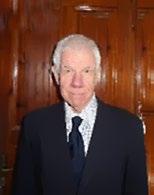
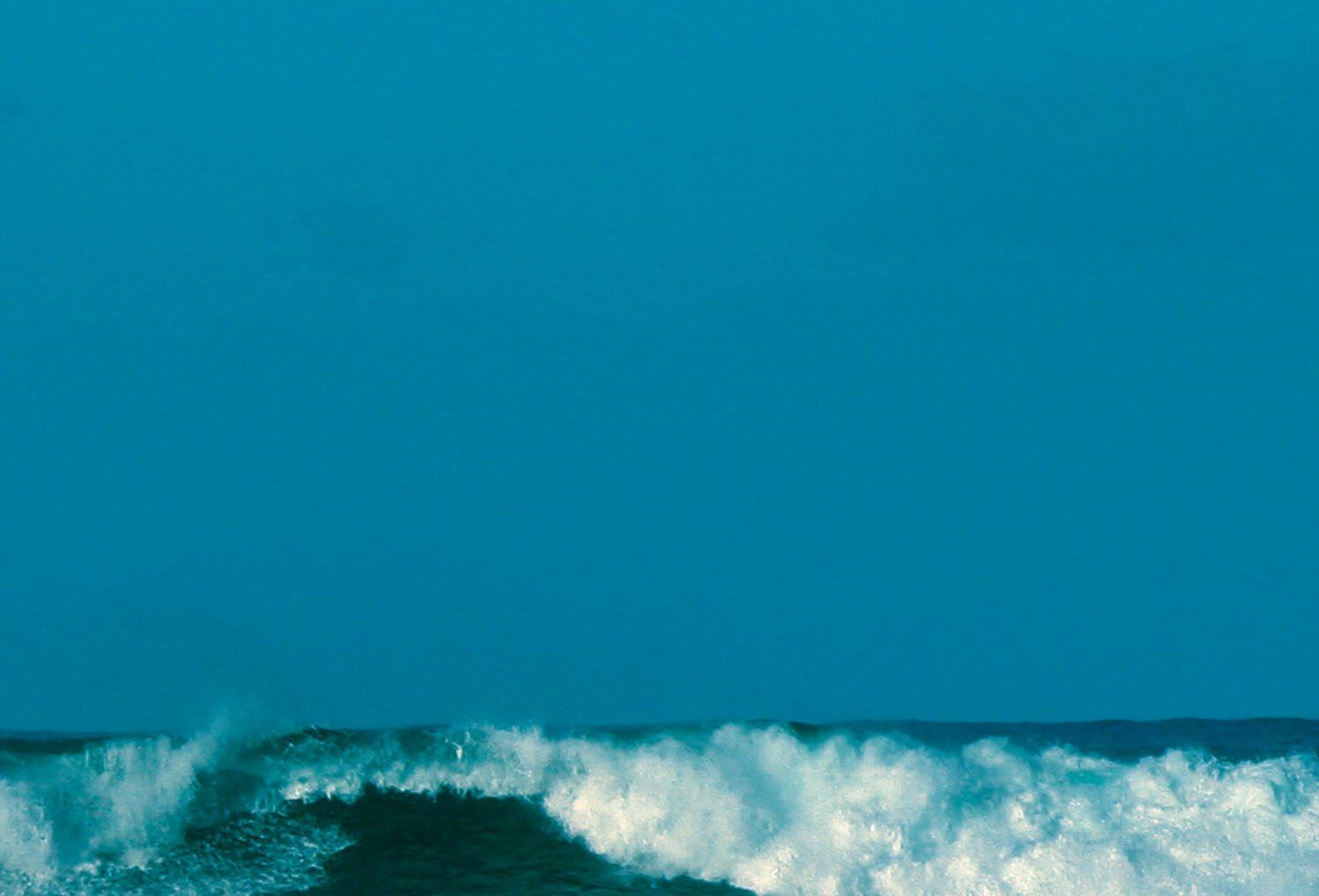
aforementioned safety achievement remains the same. As strange as it may seem, in this ever-changing environment we need to continuously change, adapt and improve in order to remain on top. In brief, we need to embrace the changes and make them part of our continual improvement process, both as individuals and as an organization.
The book titled “2023” is now about to close. The last pages are being written and it is full of experiences and memories, some of which have been for the better, and some for the worse, but all have been equally valuable. The coming year is like a blank book and it is in our power to make it another great year. Perhaps we’ll use a pencil, or a different pen, or images, or maybe due to the pace of change the book will now be digital and we’ll need to adapt. Still, the content is ours to write, and we have the power to make it the best one so far. I firmly believe that 2024 will bring around even more changes, and at the same time even more success for each and every one of you.
All the best for the New Year and Safe Seas always!
publishers. Editor: Nicholas Seaman • Email: contact@wavelength.gr • Design-Production: www.remdesign.gr
In continuation of the Athens Forum, a special event took place in Makati, Manila on 27-28th November 2023. CENMAR Manila welcomed our Philippino seafarers for a two-day discussion and it was very pleasing to witness the participation of more than 120 Officers and Ratings for the first time in 4 years. Topics varied, including the Company’s latest experiences and Case Studies, recent Regulations updates and other Soft Skills Awareness.
As per tradition, a Basketball tournament was organized with more than 100 seafarers participating, creating 4 teams. After two competitive semi-finals, the Manila Bulls (representing the Officers) and the Manila Lakers (representing the Bulk Carriers Ratings) found themselves in the Tournament Final, with the
latter taking the Trophy home. A moment of silence was held in the memory of CENMAR’s Deck Trainee Vincent De Vera, who passed away in mid-November.
Furthermore, we would like to point out the loyalty awards to the crew members, some of whom have been with the Company for more than 25 years.

By Andreas Chandris
The event, along with the videos presented, was streamed live and is available on Youtube, under Centrofin’s channel.
We believe that the “CENMAR Forum” is the event that connects Seafarers with Head Office, strengthens the relationships between crewmembers and makes us all part of the same team – the same family.
(See group photo on page 14.)
If the length of the quarterly list of our promoted Seafarers is an indicator of their career development, then the 3rd quarter list of onboard promotions confirms that great strides are being made. In this quarter, thirty nine of the Company’s Seafarers were given a promotion. The list of those promoted along with their vessels and promotion details in chronological/alphabetical order appears in the table below.
22.08.23 DURILAG John Carl ALEXIA E/Tr. to WPR 22.08.23 SABAN Ace John ALEXIA D/Tr. to OS
22.08.23 VALDEZ Rolan AGIOS NIKOLAOS D/Tr. to OS 24.08.23 NONGA Neil Alvin LENI P. 3/E to 2/E
Aurobinda SEMERU 4/E to 3/E
MALIT Herdee AGIOS NIKOLAOS E/Tr. to WPR
SABANGAN Mark John CORAL ISLAND OS to ASD 15.07.23 HOROBETS Oleksandr APNOIA APR/OFF to 3/M
19.07.23 SITONES Richard CAPTAIN A. STELLATOS WPR to OLR
27.07.23 HALASAN Joel CE-HAMILTON C/Tr. to A/C
28.07.23 PERALTA John Michael SEMERU E/Tr. to WPR
28.07.23 QUILATON Carl Joseph SEMERU OS to ASD
01.08.23 TUGBANG Ralph John YANNIS P. OS to AB
05.08.23 IGNACIO Jo-Ad APAGEON STWRD to CCK
15.08.23 BATINGGAL Mick Lloyd DINO E/Tr. to WPR
15.08.23 BURGOS Reymond PHILIPPOS A. OS to ASD
17.08.23 PUMARES Henry EVGENIA P. ASE to 4/E
18.08.23 ARCENO Grengel LENI P. 4/E to 3/E
22.08.23 CONDES Jestoni ALEXIA WPR to ASE
22.08.23 DUMENCEL Joey Boy AGIOS NIKOLAOS D/Tr. to OS
24.08.23 SINGH Gunjan MIKELA P. 4/E to 3/E
24.08.23 TSYGANENKO Oleksii DINO 4/E to 3/E
29.08.23 DIGNADICE Kitch Bryan KAPSALI 3/E to 2/E
31.08.23 LOTAYO Gerico SUNDORO OS to ASD
07.09.23 DAVALOS Aldrin AMALIA M. D/Tr. to OS
08.09.23 CARREON Gerber KAPSALI ASD to 3/M
10.09.23 SORIANO Rico MIKELA P. D/Tr. to OS
10.09.23 TAMBIGA Ron Briel RUBY 2/M to CO
14.09.23 GAHUM Mark YANNIS P. WPR to ASE
14.09.23 MAGARZO Simeon Leovic DANAE OS to AB
14.09.23 TAYA John Rafael SMYRNA D/Tr. to OS
17.09.23 JALANGA Clifford LENI P. C/O to MSTR
26.09.23 MANGUBAT Arnil CORAL ISLAND ASD to BSN
27.09.23 SARAGENA Fernando Jr. DIMITRI WPR to ASE
28.09.23 FORMILLEZA Modesto YANNIS P. A/C to CCK
Once again the list covers the full range of promotions, from those that represent a move to the first rung of the promotional ladder to one that symbolizes a leap to the top rung. Whatever the step taken on the ladder, all those who have moved up are to be warmly congratulated. Your progress is something that you, your family and the Company can be proud of as it not only reflects personal growth but it also indicates a clear commitment to making improvements that will take us another step closer to Goal Zero.


In 2023, eleven (11) Company vessels indicated in the table below have successfully passed Special and/or Intermediate/Docking Surveys and seven (7) of them have been retrofitted with a Ballast Water Treatment System (BWTS). Furthermore, several new installations/modifications for compliance with new Regulations and Charterers’ requirements as well as improvement in vessel design have been completed successfully.
1 M/V Danae 1st Special Survey Modification of aft S/T bearing ASL Shipyard
2 M/V Casta Diva Intermediate Survey, BWTS Shanhaiguan Shipyard
3 M/V Duke II 3rd Special Survey, BWTS Shanhaiguan Shipyard
4 M/V Smyrna 3rd Special Survey, BWTS Shanhaiguan Shipyard
5 M/V Alliance 3rd Special Survey Guangzhou Wenchong Shipyard
6 M/T Merbabu 3rd Special Survey, CAP Survey, BWTS Oman Drydock Company
7 M/T Agios Nikolaos 1st Special Survey “Santierul Naval Constanta” Shipyard
8 M/T Semeru 3rd Special Survey, CAP Survey, BWTS Chengxi Shipyard
9 M/T Sundoro Commencement of 3rd Special Survey, CAP Survey, BWTS, Upper Deck treatment Sefine Shipyard
10 M/V Apageon Intermediate Survey Park Shipyard / Besiktas
11 M/T Namrata 3rd Special Survey, CAP Survey, BWTS Oman Drydock Company

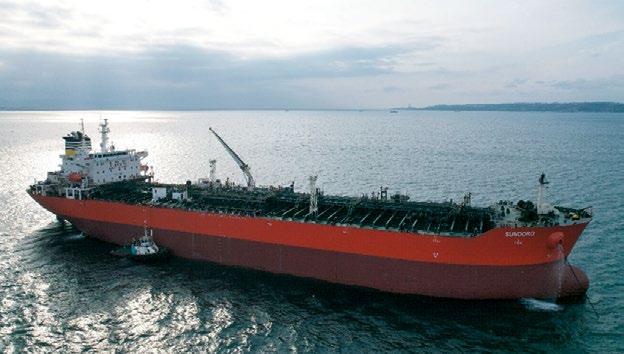




A strength assessment of the hull girder and local structure was carried out on all vessels by taking ultrasonic thickness measurements as per Class requirements. The results were satisfactory.
Condition Assessment Programme (CAP) Survey as required by Oil Major Companies for Oil Tankers reaching 15 years of age was carried out on M/T MERBABU, M/T SEMERU, M/T NAMRATA and M/T SUNDORO.
As part of the CAP Survey, a fatigue assessment of selected longitudinal stiffener connections and an identification of locations where increased monitoring is required were performed on the above mentioned vessels by ABS.
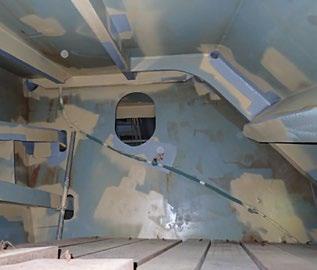


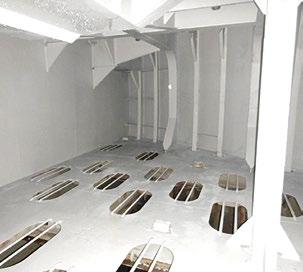
The results of the fatigue assessment and the expected fatigue lifetime were satisfactory.
It should be noted that all four (4) vessels have been assigned the highest CAP Grade of “1”, which is awarded to vessels in excellent condition concerning their structure, the coating of Ballast Tanks, Cargo Tanks & Deck and the cargo and machinery systems.
With regard to the coating of ballast tanks, the condition is GOOD in all vessels
Coating restoration works for improving condition were carried out in some areas of the ballast tanks on M/T MERBABU, M/T SEMERU, M/T NAMRATA, M/T SUNDORO, M/V CASTA DIVA, M/V DUKE II and M/V APAGEON.
Following the recommendations of the “Annual Review and Self-evaluation of SEEMP (2022)” and as per the Company’s Maintenance Policy, which strives for reduced fuel consumption, extensive hull treatment was carried out on all vessels in drydock and high performance antifouling paints based on “silyl acrylate” technology were applied on the underwater section of the hull. Polyurethane paint was applied on the topsides as a finished coat.

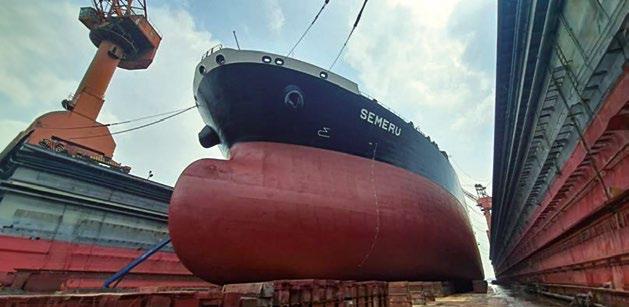

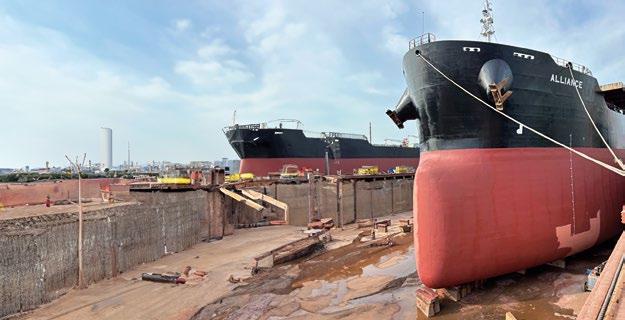
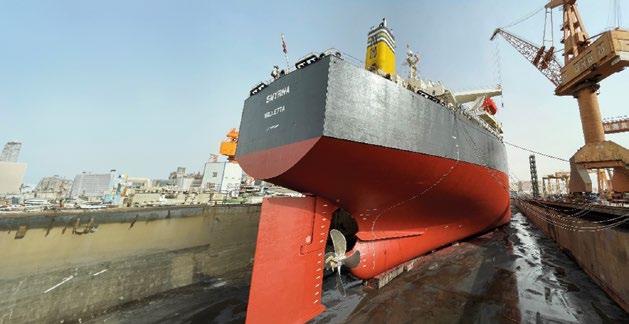



c. Deck Treatment (gritblasting & painting)
In order to upgrade the condition and cosmetic appearance of the deck structure (plating, stiffeners, frames) and deck outfitting (deck machinery, piping, platforms, supports) of our Chemical/ Product Tanker M/T SUNDORO, the following works were carried out:
- Extensive soft steel and deck piping renewal
- Gritblasting of the whole deck area
- Coating of the deck area, including piping & outfitting with anticorrosive paints and polyurethane paint as a finished coat.
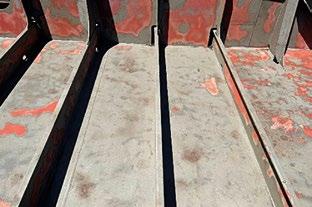
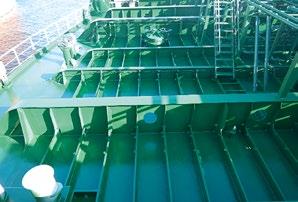
d. Cargo Holds Treatment (gritblasting/ hydroblasting & painting)
Treatment of Cargo Holds, including coating restoration works, was carried out as required in the Bulk Carriers repaired during 2023.

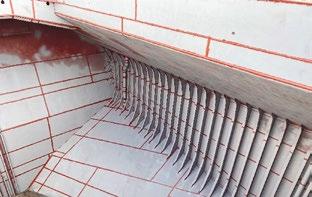
e. New Installations/Modifications for compliance with new Regulations
e.1. Retrofit Installation of Ballast Water Treatment System (BWTS)
The Company’s programme for the retrofit installation of BWTS in the Fleet has been successfully completed by the installation of the last seven (7) BWTS in 2023 as indicated in the following table:
The selected BWTS of Hyundai, Samsung and Sunrui are based on filtration and side stream electrolysis technology and have the following main advantages:
• Low CAPEX
• Low OPEX (operation and maintenance costs)
• Explosion proof type for tankers available
• Easy installation by modularized units


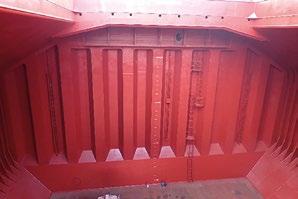
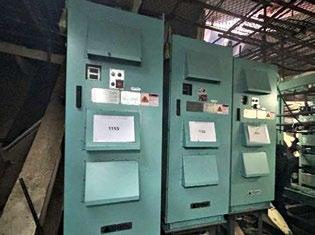
• Automatic operation
• Extended warranty period
• Supply of extra spare parts
• Free training for crew and Supt. Engineers/ Electricians

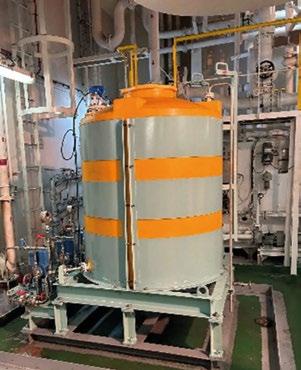


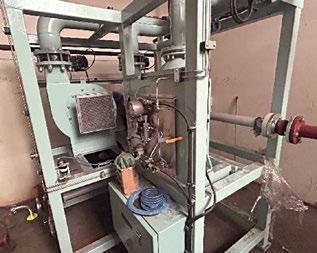

e.2. Compliance with EEXI Regulation/Installation of SHaPoLi System
The Company has decided to install the SHaPoLi (Shaft Power Limitation) system in our vessels in order to comply with the new EEXI (Energy Efficiency Existing Ship Index) Regulation.
The SHaPoLi system consists of the following main parts:
- a shaft torque/power meter with a display unit in ECR
- a SHaPoLi display unit in the wheelhouse, including a SHaPoLi module that records, processes, calculates and informs the ship’s Master or Officer on watch clearly and conspicuously when the ship’s shaft power exceeds the limited shaft power.
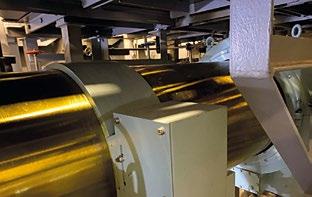

f. Modifications and Design Improvement Items
f.1. Compliance with New Panama Canal Requirements
- The installation of mooring fittings (chocks, bollards), including underdeck structural reinforcement and shelters (on bridge wings and deck) was completed on M/V DUKE II.
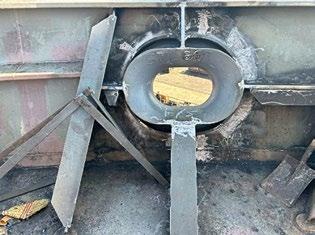


f.3. Installation of fire detectors in Accommodation cabins & other spaces
Following the fire incident in the Chief Officer’s cabin on M/T ALEXIA, the Company has decided as a best practice to install fire detectors in Accommodation cabins, mess rooms, recreation rooms and other spaces on the vessels not provided with same during their repair/drydocking period.
The installation of fire detectors in Accommodation cabins and other spaces was completed in accordance with Class approved drawings on M/T MERBABU, M/T SEMERU, M/T NAMRATA, M/T SUNDORO, M/T AGIOS NIKOLAOS, M/V ALLIANCE, M/V APAGEON.




Installation of fire detectors in Accommodation cabins / spaces
f.4. Modification of aft stern tube bearing design from “single slope” to “double slope”
f.2. Compliance with Rightship’s Requirements
In accordance with Rightship’s requirements, the following modifications were carried out on M/V APAGEON:
- The relocation of anchor chains bitter ends outside the chain lockers
- The installation of oil coamings i.w.o. hatch covers hydraulic controllers
In order to reduce the risk of aft stern tube bearing damage, a modification of its design from “single slope” to “double slope” was carried out on M/V DANAE.

Such a modification leads to further optimization of the load distribution on the aft stern tube bearing and to an enhancement of the design and operating margins in continuous and extreme transient conditions.
It should be noted that the same modification has already been completed for sister vessels M/V IRINA, M/V STEFANOS and M/V ANDONIS.

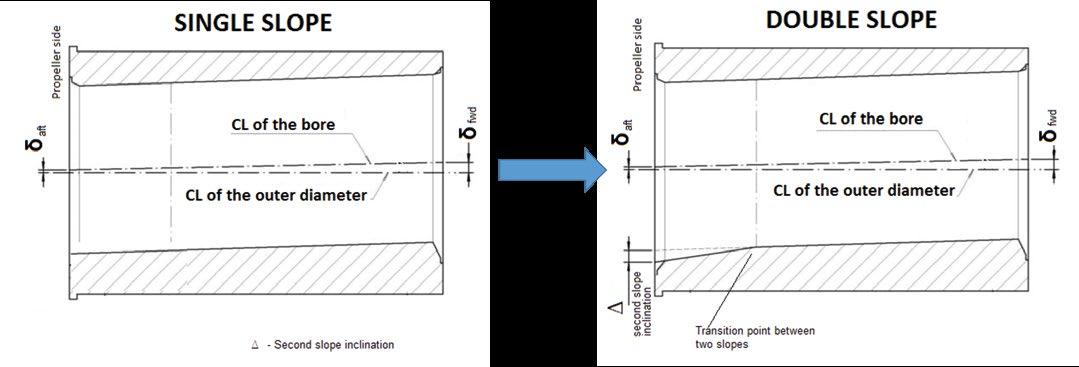

f.5. Modification of stern tube sealing system to “air seal” type
Taking into consideration the increasing trend of reported propeller shaft bearing damage on older vessels, typically above 10 years of age, operating with environmentally acceptable lubricants (EALs), the Company has decided to proceed with the modification of stern tube sealing system to the “air seal” type and the use of mineral oil in the stern tube on the following vessels: M/V DUKE II, M/V SMYRNA, M/V DANAE, M/V ALLIANCE, M/V APAGEON.
The new system is comprised of an air control unit, an S/T L.O. tank unit, a drain collection unit and a differential pressure switch for S/T L.O. pump auto changeover.
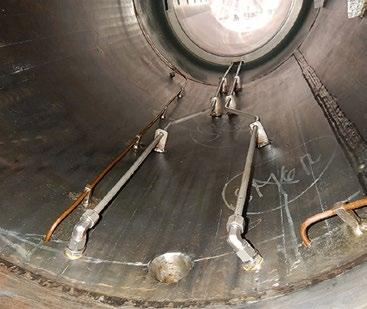

f.6. Installation of “water in oil” detection system in M/E L.O. system
As per the MAN recommendation, a “water in oil” detection
Modification of aft stern tube bearing design from "single slope" to "double slope"
system (Maker: Vaisala) was installed on the following vessels in order to avoid contamination of M/E system oil with water and thus damage to M/E bearings: M/V DANAE, M/V DUKE II, M/V SMYRNA, M/V ALLIANCE, M/V APAGEON.
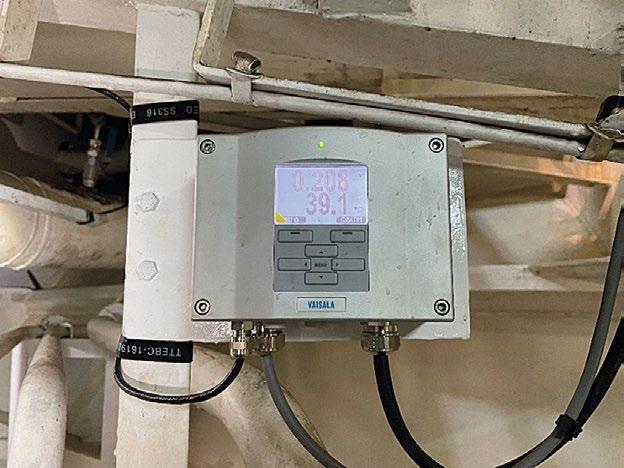

f.7. Installation of MAN “Alpha” Cylinder Lubricators
Taking into consideration the significant Main Engine cylinder oil savings and the benefits of “Alpha” Cylinder Lubricators for slow steaming operation, it was decided to proceed with retrofit installation and replacement of the mechanically controlled cylinder lubricators on M/T SUNDORO and M/V DUKE II.


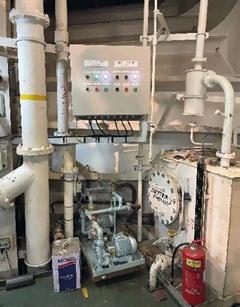
MAN "Alpha" Cylinder Lubricators
f.8. Installation of a 10µ M/E F.O. automatic backflushing filter
As per the MAN recommendation, a 10µ M/E F.O. automatic backflushing filter for protection against cat fines (Si+Al) in fuel oil was installed on M/T SUNDORO.
f.9. Modification of Cargo System
The modification of the cargo piping system and the installation of ten (10) cargo valves in Slop (S) and P/R on M/T SEMERU and the installation of six (6) cargo valves in Slop (S) and P/R on M/T MERBABU in order to enhance cargo operational flexibility and reduce cargo discharging time were carried out.
This modification enables:
- Double valve segregation in all stages of the cargo discharging operation
- Slop Tanks to be in different cargo groups
- Each Slop Tank to be used as primary tank
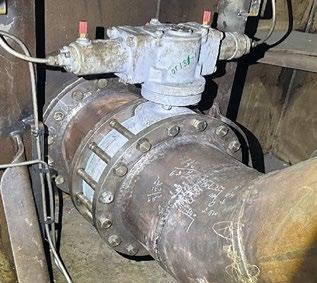

A retrofit installation of the ‘’Hanla’’ Vapour Emission Control System (VECS) of was completed on M/T AGIOS NIKOLAOS.
The system consists of an Oxygen/Vapour Pressure Detection System (oxygen sensor, vapour pressure transmitter) with an alarm repeater in CCR.


The modification of cargo hose handling cranes for personnel transfer was completed under the supervision of the Maker’s (Oriental) Service Engineers on M/T MERBABU, M/T SEMERU & M/T NAMRATA.
The following parts were installed on the cranes:
- Hoisting reducer
- Secondary brake for personnel
- Mode selection with relief valve
- Start/stop switch for personnel
- Warning light for personnel
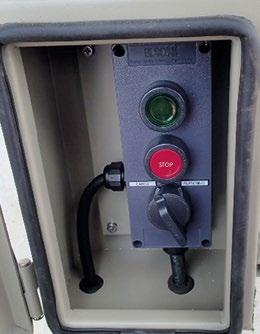

f.12. Installation of mechanical extraction fans in Dedicated Smoking Rooms
The installation of mechanical extraction fans in Dedicated Smoking Rooms were installed on M/V DUKE II, M/V SMYRNA, M/V ALLIANCE, M/V APAGEON, M/T MERBABU, M/T SEMERU, M/T NAMRATA, M/T SUNDORO & M/T AGIOS NIKOLAOS.

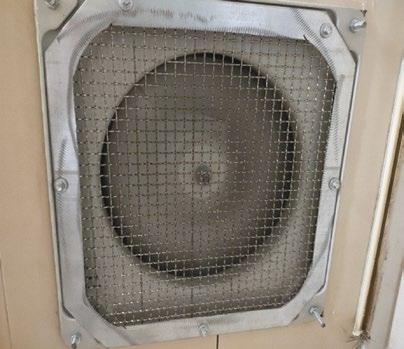

Loading and discharging operations of tankers require the utmost care due to the hazardous nature of liquid cargo. Every crew member must be aware of the basic best practices and support the senior officers by reporting any deficiency or nonconformity that they may notice. A small deficiency, an omission or a mistake can easily develop into a serious problem involving a fire, oil spill or even an explosion.

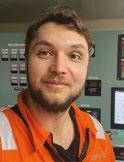
Safe operations are guaranteed by the proper functioning of equipment and alarms and by having all the crew properly trained and familiar with the ship’s systems, lines and valves. Resilient crew members will be able to respond effectively in emergency situations in addition to carrying out their routine duties.
Some of the items that will ensure a safe and efficient operation are listed below:
1. Familiarisation. Sufficient overlap is provided to senior officers who, in turn, have to ensure that the whole crew is thoroughly familiar with the essentials of shipboard operations in the least possible time.
2. Cargo Plan awareness. Cargo stowage should be discussed in detail for all cargo tanks with all crew members involved in the loading operation during the preloading meeting.
3. Cargo stowage is to be displayed in the CCR. The most common incident in tankers is the shifting of cargo from one tank to another due to a valve that is not holding. Cargo tank ullages, mean cargo temperatures and IG pressures after loading and as per bill of lading should be posted in the CCR. These values are thereafter compared with the Cargo Monitoring System display and provide an early alert of cargo shifting from tank to tank
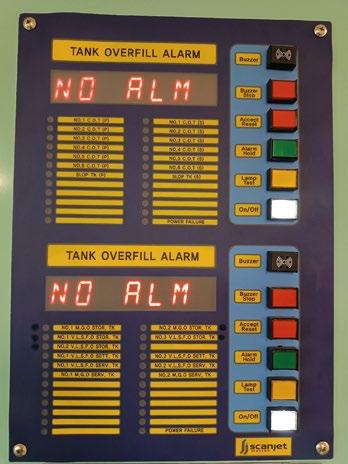

4. Cargo tanks High & High-High level alarms. These are a very important safeguard against tank overfilling. The high level alarm system must be in operational condition at all times during cargo handling. It provides an early warning and allows operators to take action against any operational error (e.g. wrong lineup of valves) or latent defect (cargo valve not holding).
5. Cargo tanks Inert Gas pressure. The remote pressure indication system has to be fully operational in order to carry out IG topping up to cater for any pressure fluctuations due to ambient temperature changes.
6. Inert gas inlet valves must be in good condition and always remain open. Shutting off the IG inlet valve together with a malfunctioning PV valve may cause severe structural damage to the tank due to vacuum or overpressure.
7. Oxygen /H2S content checking must be carried out regularly with calibrated equipment.
8. Cargo heating lines should be tested and maintained according to the ship’s PMS. Additional testing is required before carrying a heated cargo.
9. 9. Cargo and COW lines pressure testing has to be carried out prior to discharging. It is advisable to carry out the test well in advance in order to have sufficient time to rectify any leakages.
10. Cargo pumps are to be reset after the tripping test to ensure a normal start during cargo discharging. The remote trip should be tested after the steam turbine rpm has been reduced to a minimum to avoid any pump
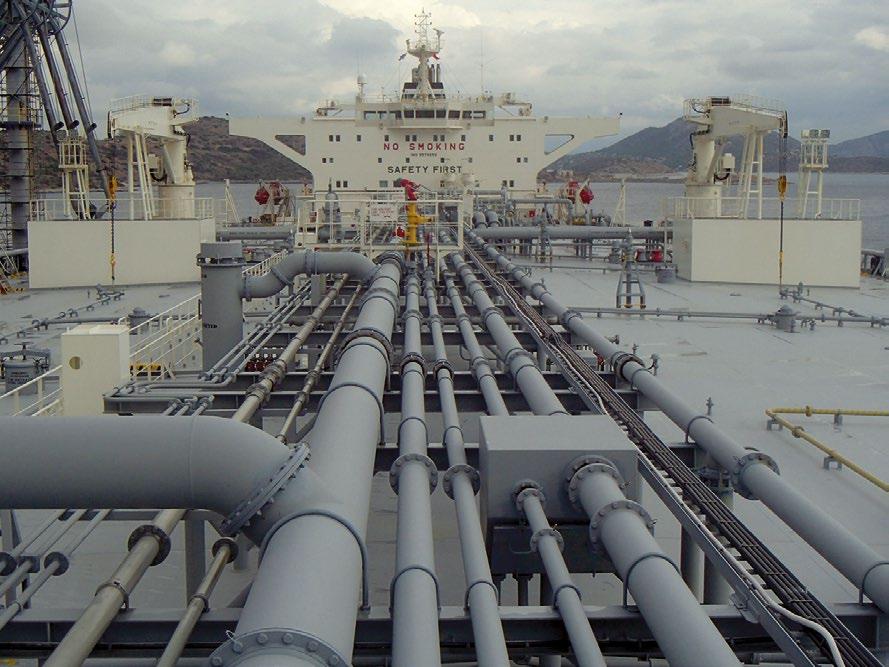

racing at a high rpm when restarting. There have been cases of serious steam turbine damage due to governors stuck at a high rpm.
11. Pre-arrival checklists (prior to arrival at discharging port before commencing discharging) are to be strictly followed to ensure that all necessary inspections and checks are made in an organized way.
12. Cargo valves discharge line-up. Before commencing a discharging operation, the cargo tank line and pump room valves are to be set according to the discharging plan. The cargo valves line-up must be prudently verified by two officers and recorded in the cargo log book.
13. Cargo pumps are to be regularly inspected during the discharging operation to ensure that they operate normally without signs of vibration, bearings overheating or leakages in way of mechanical seals
14. Alarms should never be ignored whether it is a bilge alarm or an equipment alarm. Alarms should be identified promptly, followed by a positive response and rectification of the cause of the alarm.
To conclude, all crew involved in the commercial operations (loading or discharging) must be vigilant at all times, maintain effective communication, avoid complacency and follow the Company’s procedures and manuals precisely.
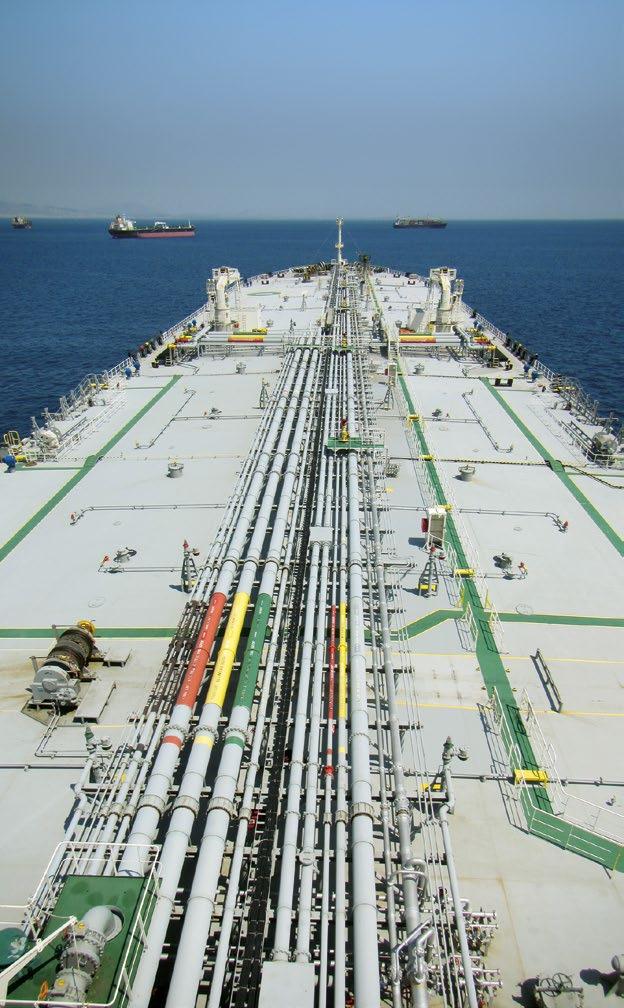
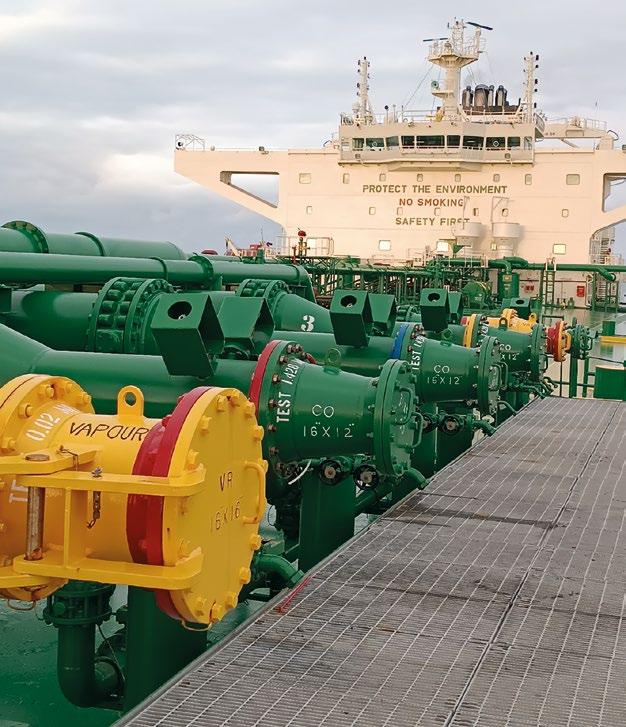
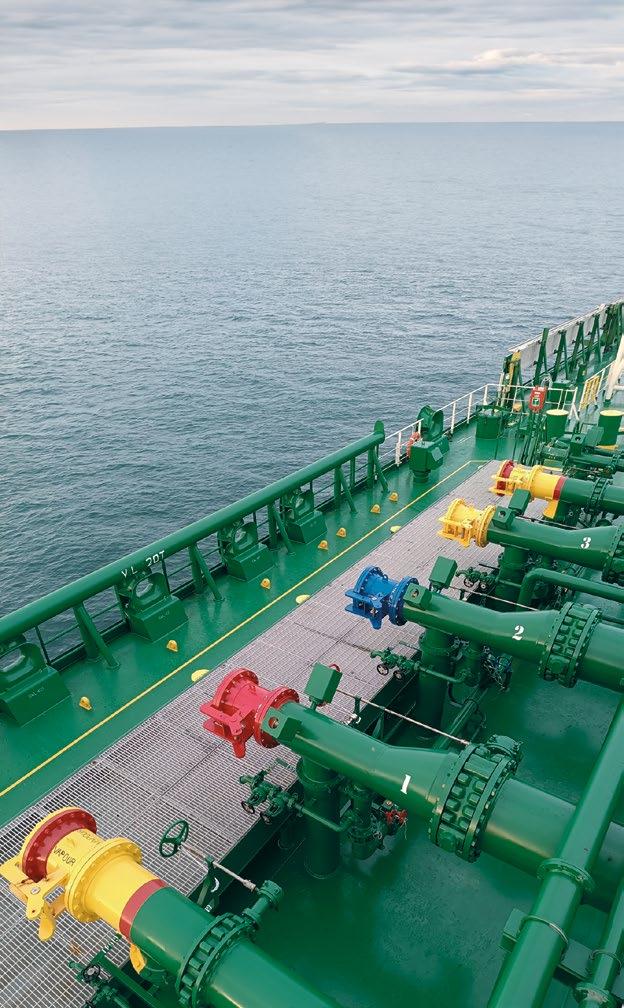

by Nasos Skouras
In the dynamic world of maritime operations, the role of a Crewing Officer in the Crew Department of a shipping company is crucial to ensuring the harmonious and efficient deployment of qualified seafarers. This demanding position requires a unique blend of organizational skills, industry knowledge, discretion and empathy. Having worked as a Crewing officer for a number of years, I will be able to share with you a typical day in the life of a Crewing Officer, as my colleagues and I navigate the challenges of managing a diverse crew while maintaining compliance with international regulations.
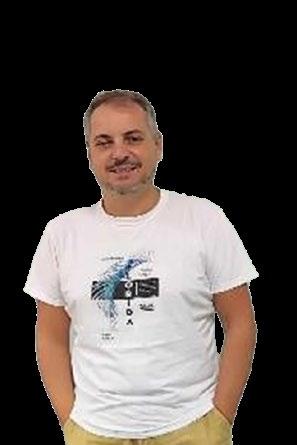
The morning kicks off with a meticulous review of crew scheduling and assignments. We are responsible for coordinating the deployment and relief of seafarers on vessels in every fleet, ensuring that each ship has a fully qualified and properly certified crew. This involves managing a vast pool of our Seafarers, each with their own set of skills, experience, and contract specifications.
One of the primary tasks is to liaise with the Captains to understand the specific needs of each ship. This involves careful consideration of factors such as the vessel's type, route and operational requirements. Having to balance these factors with the availability and preferences of our Seafarers to create a cohesive and efficient crewing plan is the most demanding task.

Navigating the intricacies of international regulations and certification is a daily challenge. We ensure that all seafarers meet the compelling requirements set by regulatory bodies and national maritime authorities. This is a team effort, including my colleagues’ valuable contribution, which entails monitoring the expiration dates of certifications, arranging necessary training programmes, and keeping abreast of changes in regulations that may impact crewing procedures.
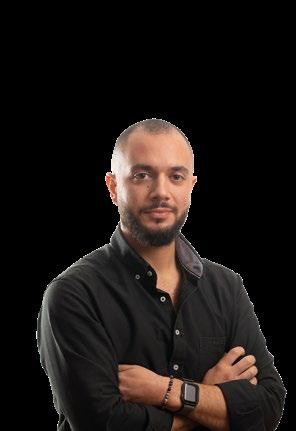
As the day progresses, we engage in constant communication with our Seafarers and our RPS agencies. We handle inquiries, provide updates on deployment schedules, and address any concerns or issues that may arise. Building and maintaining strong relationships with the crew is vital for morale and effective communication, which is especially crucial in the maritime industry where crews are often away from home for extended periods.
In addition to day-to-day operations, we have to review applications, conduct interviews, and assess the qualifications and suitability of potential seafarers. The goal is to ensure that the Company has a reliable pool of talent to draw from when filling vacant positions or expanding the fleet.

The afternoon may bring unexpected challenges such as last-minute changes in crew assignments or dealing with emergencies at sea. This is where we have to be adaptable and ready to respond swiftly to ensure the safety and efficiency of operations. Our job extends after office working hours as many of our vessels travel on the other side of the globe. We may have to arrange flights within the night or talk with agents about a Seaman’s transfer to hospital. It may be the case that we need to put our personal life aside to care for a Seafarer who is struggling away from home.
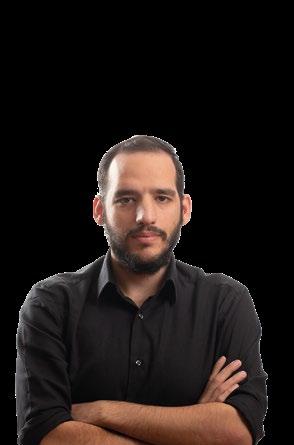

By working in one of the most challenging departments, as it has to deal with the human factor right from scratch, we have learned how to remain resilient even in the most stressful situations. There may be times when we feel anxious or stressed, even disappointed, but when we hear a happy voice or see a smile on a Seaman’s face, or read his relief in his message, then we know we’ve done our job till the next morning, when a new marathon starts again.
The Crew Department would not be the same without the valuable contributions of our support staff, whose work will be acknowledged in a separate article.
discretion organization rewarding empathy resilience schedules knowledge meticulous efficiency communication positive feedback
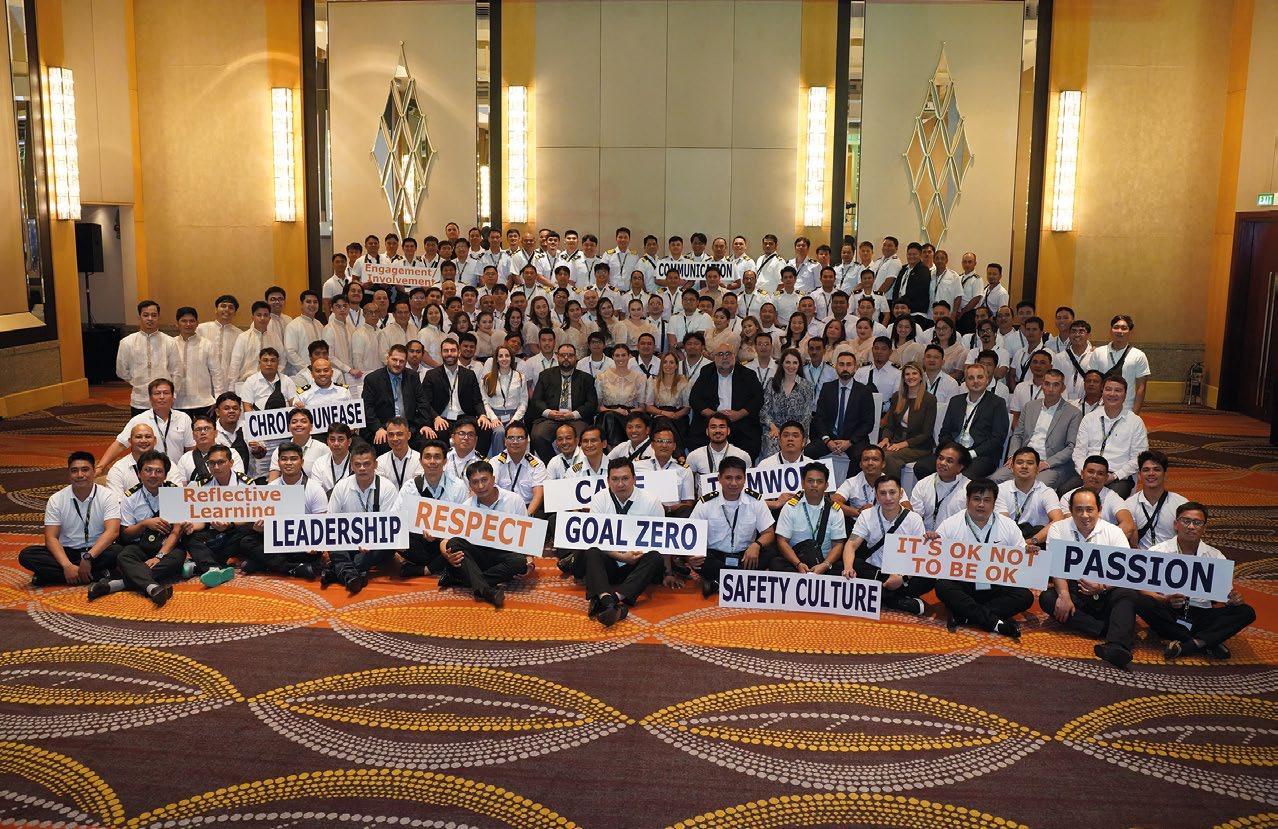

The human being as understood has 3 Qs to his or her intelligence. These are IQ, EQ and SQ.
IQ (Intelligence Quotient) determines the general intelligence, EQ the emotional quotient and SQ the Spiritual Quotient. A person with a high IQ is generally good at mathematics, problem solving, and logical reasoning.
EQ determines the emotional stability and higher thoughts, which directly correlate to co-operation among individuals, better communication, managing complex problems and tackling a bad situation. Generally, a person in senior posts such as director etc. should have a higher EQ.
SQ determines the different dimension of a person. It relates to whether a person can think beyond the mundane and see the ‘Magic’ that ‘Life’ actually is.
Every human being develops a consciousness that has these three Qs in various proportions. So it can be said that IQ + EQ + SQ determines the quality of one’s life. A person may be highly intelligent but found to be at odds with others. Such a person has a low EQ. A person may have a highly successful career or business, but may be a disaster in life. Such a person generally has a low SQ.
The consciousness that we have can be divided into three parts: sub-conscious when we are asleep, for example, conscious when we are working and super-conscious when we can tap into the very source of creation throbbing within us. The level of realization in our consciousness, determines the amount of SQ that we possess.

The ‘Ego’ is actually lack of perspective. The galaxy we live in, the ‘Milky Way’, is actually a speck in the universe, our planet is actually a micro speck, the countries and companies a super micro speck. A problem arises when we have a ‘Big Man’ or ‘Big Woman’.
By Satya Sunder Ghosh
We are a momentary pop-up in this infinite creation, and this realization should keep us grounded.
The second most important thing is the ‘Dignity of Honest Labour’; An honest and hard-working Sweeper is far more dignified than a dishonest Prime Minister.
This point should not be lost on anybody and titles and position shouldn’t cloud one’s judgement.
I am Jayson C. Padilla. I am 44 years old from Nueva Ecija, Philippines and currently on board Evgenia P. as Master. I have been working for the Company for almost 9 years. When I joined I was a Second Officer full of aspirations and looking for a better company to sustain my family needs. Having been a Second Officer for 12 years, becoming a Master was no longer in my plans. At that time I was already satisfied with my position and I enjoyed what I had been given.
However, some of my previous Masters, fellow seafarers and my family motivated me for career development and I started to envision change and focus on my new aim with strong belief. In 2018, after 3 years, all my hard work paid off and I was promoted to Chief Officer, which not only gave me success but also confidence and something to be proud of. My journey continued by facing all the challenges while striving to remain calm, promoting a safe working environment and levelling up the working standard. I shared the experience and knowledge I had gained with all my fellow seafarers in order to produce competent Officers and ratings who would contribute to our Company aim to achieve GOAL Zero.
In 2023, I was promoted to Master and I am very thankful to our Company for giving me this opportunity. This is not just any company but a family. Rest assured that the Company’s objectives
I am 2nd Officer Alaine Jun Matapaja. I am 39 years of age. I studied my maritime course at John B. Lacson Colleges Foundation –Bacolod from 2000 to 2003. Before I started my maritime career, I was working as a bagger in some big supermarket (SM Manila) and some restaurant around Manila while looking for some shipping companies. It was an opportunity for me to be hired at Cenmar Manila with the help of previous Cenmar family circle of senior officers. I started as a utility at Cenmar Manila way back in 2007 and 2008. After a few months of being a utility in the office, I embarked on MV CE-Alliance as a deck cadet in 2008. I worked hard and never stopped learning while on board. As a cadet, I set a goal for myself that someday I would be an officer, too. All the hard work and learning that I did paid off as I was promoted to Able Bodied Seaman in 2011 on MT Mikela P. with the help and guidance of my senior officers and colleagues. As time passed by, I aimed to continue my greatest goal to become an officer. In 2015 I decided to take the officer’s examination. Fortunately, I passed and obtained my license. I was inspired a lot by my family for all the hardship I had been through. I’m here for them to support

are given priority and I will set an example as a leader to motivate and produce aspiring Officers and crew with strong motives in the industry in order to maintain safe operations on board at all times. I hope that by sharing my experience somehow, this will be an inspiration to the younger generation to know that perseverance pays off.

I would like to take this opportunity to give my warmest thanks to our Crewing Department, our Marine Superintendents Capt. Orfanos and Capt. Kozaos, Navigation Superintendent Capt. Roche for the positive results during my interview as Master and their guidance on day to day work at sea. I would also like to thank our active Masters Capt. Vinluan, Capt. Ugat, Capt. Moreno, Capt. Mendones, Capt. Kopchenkov, Capt. Knyzhko, Shipboard training Officer Capt. Reyes and to all the Masters with whom I have worked who gave me their personal advice. Thanks are also due to Lydia Mavropoulou from Marops for always assisting and guiding me and lastly to all the Departments and management at the Company for their never-ending support. I am truly blessed to have you all by my side. Salute.

and provide them with their basic needs. In 2017, I was promoted to 3rd officer on MV Calliope P. with the help and support of my senior officers and colleagues who encouraged me to take my first step to become an officer. My family was very proud of me and my career achievement in the maritime industry. In 2022 I was promoted to 2nd officer on MV Casta Diva again with the help of my senior officers who helped me to reach the next level of my career. I am now on board MV Nilos as 2nd Officer.
I have been with the Company for almost 14 years, during which time I have completed 8 years of sea service. Being a sailor is not an easy job for us; we are miles apart from our family and loved ones. Being a sailor is not just about making money. It is also about meeting new people on board and gaining and sharing knowledge with each other.
I am very grateful for being a part of this Company, for what I am today because of my admirable superiors and fellow employees. Thank you for all the support, help, opportunities and trust that you have given to me. I’m here to do the best I can to perform my duties and responsibilities and to be an inspiration and an asset to the Company.
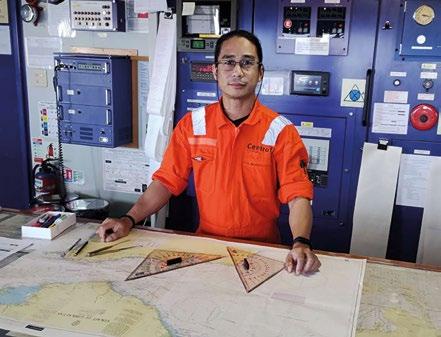
I offer this to my supporting families for all my achievements.
“A New Dawn, A New Day, and A New Chance to be what you have always wanted to be.”
MESSAGE FROM THE DPA:
Dear seafarers,
I do feel that over the past few years our Safety Culture is constantly on the rise. But we must now strive to find new ways to reach even higher levels for our safety mindset.
The traditional approach to safety is typically focused on analysing past undesirable events. But why not strive to learn from why things go right as well so as to help further develop an effective safety culture?
Bring up safety even if nothing is wrong!
You can offer a compliment to your coworker who is working safely!

Moreover, a holistic approach is when you:
- are the owner of your mistakes so that you can be the owner of your success.
- abolish the shame of failure.
- encourage your team members to Speak Up.
Keep in mind that:
- Diversity of opinions results in better safety outcomes.
- If you are not actively including, you are accidentally excluding.
I wish you safe voyages and a safe return home,

1. Prior to use, all tools should undergo daily inspection and safety checks.
2. Safety guards should never be modified or removed from any tool.
3. Test and visually inspect the wiring and overall condition of electrical tools to ensure safety.
4. All users must be equipped with and wear appropriate face shields, eye protection, hearing protection and the correct type of safety gloves when using any power tool on board.
5. Provide comprehensive training on the safe use of tools to all personnel and conduct risk assessments.
6. During temporary interruptions to work, equipment should be isolated from power sources and left safely or stowed away correctly.
7. Seafarers should be advised not to use high speed rotating tools for more than 30 minutes without a break unless the risk assessment indicates a shorter maximum period of use.
8. Ensure that the right disc is being used for the right material and at the correct speed. Discs come with a max rotations per minute (rpm). This should not be exceeded.
9. Discs on grinders should be changed when they are worn in order to prevent kickback.
10. Install chain linkages or comparable mechanisms between hose sections to avoid pneumatic hose breakage and subsequent hose whiplash. Safety valves that shut off the lines can also be used.
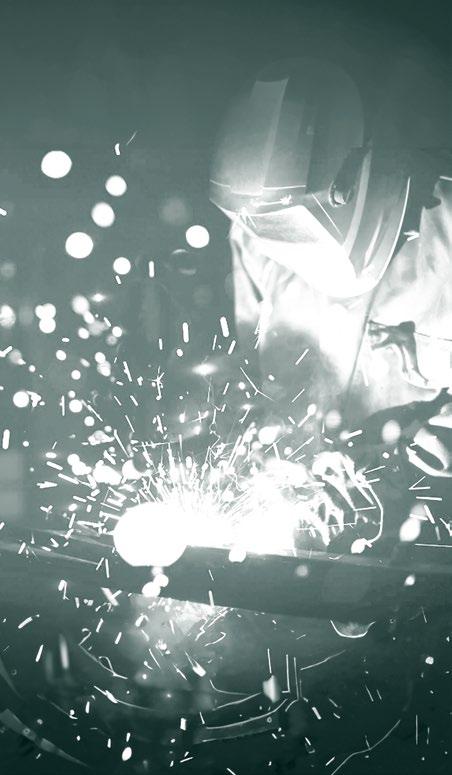
The issue of emergency response is covered by your ERP manual. However, this mostly focuses on the interaction between the ship and the shore. What is often overlooked is the interaction between the bridge and the engine room teams.
Source: Britannia P&I

After an incident, the following factors should be communicated clearly and concisely, using simple language to ensure all involved are aware of what is occurring so that the most appropriate support from one team to another is put in place. This also enables the most suitable help to be sought from third parties, be it port state authorities or the vessel’s managers: WHAT HAS HAPPENED? WHERE HAS IT OCCURRED? WHY HAS IT TAKEN PLACE? WHEN DID IT HAPPEN?

CONCISELY– at the start just give prompt and sufficient information to enable appropriate action to be taken. Further advice can be provided later; hopefully, once a situation stabilises. Keep communication simple and to the point.
OPENLY – do not withhold any information as it is important to share all information and trust the other members of your team – holding back information can be unhelpful.
CALMLY – always remain calm; shouting down the telephone or radio helps nobody. Being calm will show others that you are in control and hopefully promote a calming influence at a time of confusion and stress. Remember that teams are busy and so avoid asking for repeated updates as this can hinder the operation.
SHARING – while not wanting to press for updates, it is important to share information between the teams with periodic contact and updates and reassurance. It can help to share an approximate timeline and indicate when further information is expected.
CONSISTENTLY – it is important that messages are consistent to the bridge or engine room teams, as well as to others on board such as an emergency response team, or fire party.
LANGUAGE – it is natural that in times of stress people will often revert to speaking in their mother tongue. This can cause confusion and lead to information not being shared. It is important to highlight in crew training the importance of staying calm and trying to use the working language of the ship, which is English, at all times.
COMMUNICATION – usually telephones are used to communicate between the bridge, engine control room, engine side and steering flat. Back-up communication systems should be available and should be regularly tested as part of the Planned Maintenance System. These could include sound powered telephones, talk-back systems and remote telephone handsets. Walkie talkie systems should be tested in the machinery spaces to find out where any ‘dead spots’ are and alternative means of communication should be organised in advance of any emergency.
REMEMBER! The bridge and engine room teams will need to work together in an emergency situation, and clear, concise and measured communication is a key factor in ensuring a successful outcome for all parties. This highlights the absolute necessity and importance of conducting frequent realistic onboard drills to prepare the crew for stressful emergency situations.
Voices from the Fleet (Part 2)

In October 2022 we launched an H&S Campaign, 07_2022 on Leadership, introducing the "Leadership Card" to our Senior Officers serving on board the vessels of the fleet at that time. The campaign lasted till 31/3/23 and out of the 42 (forty-two) vessels and 168 (one hundred and sixty eight) Senior Officers, 65 (sixty five) reverted with their feedback. Given the fact that it was completed on a voluntary basis, it can be considered a good response with room for improvement.
Among the characteristics of a Great Safety leader, the following were rated as most important:
- Respect and care for all people
- Seek and welcome feedback and coaching from others
- Promote the “NO BLAME” culture / React positively to mistakes / Care about “WHY” and “HOW” / Never ask WHO


- Develop and improve / Admit to your mistakes
- Lead by example and offer coaching / Be the model of safe behavior
Embracing every opportunity to learn to drive continuous improvement and focus on learning and improving, particularly when something did not go well were the two characteristics that inspired our Senior Officers most. Additionally, responding positively to ideas and concerns raised about our people, embracing every opportunity to learn to drive continuous improvement and focusing on learning and improving, particularly when something did not go well were the three most common responses our Senior Officers related to.
Among the valuable feedback we received, we would like to share some of the views expressed:
“Reverting with my feedback on H&S Campaign 07/2022 - Characteristics of a GREAT Safety Leader. First of all, it is really a GREAT idea to determine for yourself if you are a great leader and can lead the people (crew particularly) to accept all possible mistakes without blame. Such a campaign could assist anybody (not only the leader) to improve their own behaviour in their relationships with other people. Learning and improving is vital. My journal is continuously kept up to date and is not completed yet."
“I was able to apply the Characteristics of a Great safety leader, motivate workers to be at their personal best, which makes them both want to personally adhere to safety initiatives and do everything safely. A leader is also responsible for finding ways to continuously improve safety culture in the workplace and being a great safety leader isn’t easy. It takes certain characteristics to excel such as compassion, excellent communication skills, ability to inspire, selfawareness, ability to be fully present and a commitment to learning, but most of all as a great safety leader you need to care deeply about your people and regularly demonstrate the value of safety through your actions.“
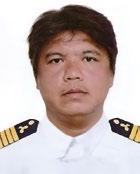

“The contents of the campaign were very helpful because they guided us how to be a good leader and to correct our mistakes, how to handle our subordinates or crew. I also learned how to approach the crew in the right way. Respecting each other is one of the important factors on board to have a good relationship between the crew and the leader. I also learned to listen to other opinions or suggestions in case we encounter any trouble or problems on board. Being able to recognize and reward hard work by always thanking them for their focus and determination, especially when they go above and beyond to complete difficult tasks to reach a goal. Similarly, effective communication is at the heart of every success, and a good leader must constantly reinforce this skill and reassure them that you are impressed with how they handled the process. The leader should be a good example or model for the crew and should demonstrate respect and care for others. The blame culture should be avoided. If somebody has made a mistake, teach them instead of blaming because finding blame does not lead to improvements. We should celebrate the small victories and show our appreciation. Find ways to inspire the crew to take initiatives on their own, show them how impressed you are with their leadership, express gratitude to them, and encourage them to continue the good work.”
“I found that our campaign in Characteristics of a GREAT Safety Leader, accompanied by a relevant card and journal is a very helpful tool in improving oneself to be a good leader and human being onboard. It helps me to be a better version of myself. I found that my crew are happy and the working environment is much better. My crew is more open to talk about their feelings and problems. We encourage them to speak up and ask questions if in doubt. As I always advise everybody "Be Humble Enough to obey, as YOU will Give Orders Someday".

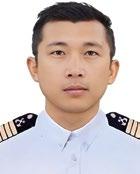
“My feedback about the course campaign is always be a good example to them by having a positive mindset to all problems that may arise. Listening and encourage them for a bright future, be responsible for their actions and a good working harmony will result."
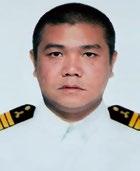

“The ability to be inspirational is what a leader needs to be able to inspire others. Have good communication with your fellow officers & crew, and teach important principles especially in working daily jobs. Have the ability to set goals, strategies and a course of action in a difficult situation and keep people focused on the goal. Overall, leadership is the challenge to step up to a new level, a dimension that has both opportunity and responsibility. In addition, this campaign is very useful to help us become great safety leaders.’’
“I am very much impressed with the Principles of Dr. Todd Conklin. The principles seem to be very brief but they can create more impact on leadership quality. In the present scenario of shipping where inspections and audits are more, the possibility of blaming others is also high. That is why the no blame culture should be emphasized. The blame culture will only let down the people whereas the learn and improve culture seems to be able to uplift people along with me in every situation. When I am open to constructive comments and accept them genuinely, my subordinates feel more confident and open up to accept their mistakes. The leadership card has created a big impact on my decision making and behaviour in a constructive way which is very much accepted by the crew and officers. I thank the SQE department for bringing up such innovative and insightful thoughts.”

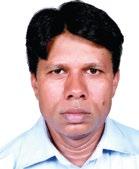
“I was able to apply and promote the “NO BLAME” culture on board and react positively to mistakes, caring about only the “WHY” and “HOW”, and not the “WHO”, with understanding that human error is normal. Error is an unintentional deviation from an expected outcome. We are all prone to mistakes and we must accept that. We must understand that errors are an opportunity to learn and improve. Everyone can make mistakes, we are all human, so reacting positively and with understanding is a good characteristic for a Safety Leader. “No Blame” is a culture promoted on board as part of Company policy and my own feature.”
“Campaign contents are interesting and useful. They help to identify and enhance the characteristics of a leader, which are normally missing or remain hidden. Some are a very minor gesture, but if they improve, they can encourage correct feedback in two way communication and increase confidence among subordinates.”
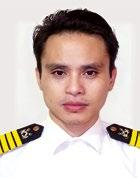
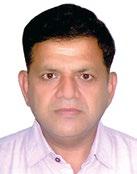
“As a Great Safety Leader, you should always need to be looking at your current processes to gauge their effectiveness and seek even better ways to protect your team. Continuous learning is a huge part of how to improve safety culture. Keeping up with the latest rules and regulations, training sessions and seeking feedback from your team.”
“On personal opinion, if the campaign is inculcated to senior officers’ minds and learned or developed by heart, the wellness of individuals will be enhanced, operations will run smoothly and camaraderie will prosper. It may also alleviate the hardships and loneliness of being away from each family as leaders are willing to listen, share endeavours that will surely comfort every individual knowing there are persons who they look up to, ready to lend their time and kind words. As of now, great steps are starting with small strides in the campaign.”


“Sometimes we’re working so hard to meet our goals, we forget to stop and celebrate when we do. Show appreciation, and celebrate the little wins. Tell them that one of their strengths is that one almost always delivers projects on time. Some talented people really struggle in that area. Our clients expect it, and hitting these goals is critical to everything that we do. On another note, tell them they have learned how to maintain a workload that’s ambitious, yet realistic, and so everyone is better for it.
Helping others is another notable attitude that is achieved by having the team player attitude and servant leadership. I really thank them for these qualities towards commitment to the greater good. For instance, their willingness to look outside of themselves and those around them better is one of the most valuable contributions they’re making.”
Leadership is a very broad area and exercising it needs a lot of practice. Thus, it may be decided in the future to run another campaign on specific aspects of leadership.
When you feel a difficult or complicated emotion, what do you do?
A. Judge yourself for it ("I shouldn't feel this way.")
B. Beat yourself up for it ("I'm a bad person for feeling this.")
C. Pretend you're not feeling it ("I'm fine, what do you mean?")
D. Accept that you're feeling it ("I am feeling this right now and that's okay.")
If you've answered A, B, or C, I've got a tool for you in this newsletter that can help you to change the way you respond to your feelings — and improve your relationships, happiness, and health along the way.

Here's a simple way to start accepting your feelings:
• Practice observing them. Tilt your head downward and look at your chest and imagine that there is a box over your heart, full of whatever emotions you are feeling. Try it: what do you see?
• Practise labeling them. Use the New Happy feelings wheel to describe those emotions. This helps you calm down your instinctive reaction and shift into a more mindful response.
• Practise giving yourself compassion. Say to yourself, "It's okay that I'm feeling this," or, "This is hard, and I am here for myself." Consider what this emotion might be telling you about what you need and want in your life.
Old Happy: "To cope with my feelings, I have to deny them.”
New Happy: "To work with my feelings, I have to accept them.”
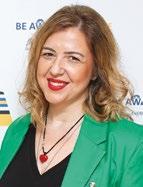
By Chara Markatzinou
If you frequently choose A, B, or C, you’ve probably noticed that these strategies don’t magically make your difficult feelings disappear.
Judging, berating, or hiding your feelings just mutates them into something else, something that ends up hurting ourselves and others. For, quite often, we end up taking out those emotions on other people:
• We judge other people’s emotions.
• We feel angry at others for feeling their emotions.
• We silence other people’s emotions.
Multiple studies have found that accepting your negative emotions is a key contributor to mental health. It is related to less stress, less worry, and less anxiety. Further research shows that when we believe that all of our emotions are acceptable, we are more likely to choose healthier coping strategies that help us refrain from lashing out at other people.


Tips and Tools


it has to feel like this before it feels like this
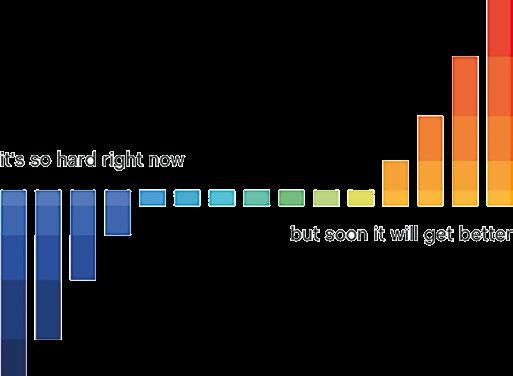
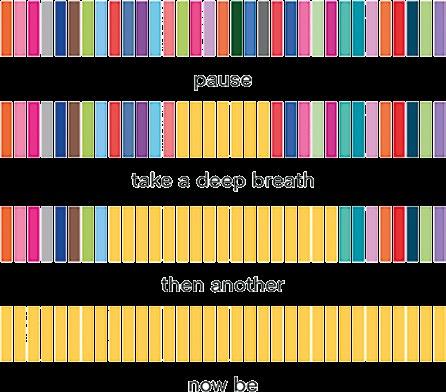
The adventure of life is to learn, the purpose of life is to grow, the nature of life is to change, the challenge of life is to overcome, the essence of life is to care, the opportunity of life is to serve, the secret of life is to dare, the spice of life is to befriend, the beauty of life is to give, the joy of life is to love.


Source: thenewhappy.com
Please allow me to introduce myself. I am Vaia. I am an SQE Officer and I have been working in the Company for the last 4 years.
I had the opportunity to share in previous Wavelength issues my first onboard visit to M/T Captain A. Stellatos and my experience in the first Athens Forum. I’m very happy with the opportunity to help out with Wavelength because I like to communicate with our Seafarers, which is part of the familiarization process which I like so much.


Congratulations and thanks go out to Eleftheria Lemontzoglou who started this column as Nostalgia and to Chara Markatzinou who took over the responsibility for its development and growth. Even though I am relatively new to the Company and am not an accomplished writer, I will do my best to take the section forward under its new name: ‘’Moving Forward, Looking Back’’! In this installment, there is a fitting brief introduction of the establishment and path of our Company in its 30th year followed by revealing interviews with the most senior and youngest employees together with the Company’s current activity and position.
ENTER CENTROFIN: A major milestone came 30 years ago. In late 1992 Centrofin was established in order to follow a separate path from the existing family business. With relatively few resources, the Company acquired its first vessel on January 8th, 1993. The NINEMIA was an undersize suezmax tanker of 123,000 tons dwt, which was built in Japan. A new chapter dawned and Centrofin started investing steadily in more modern vessels. In the early years it was mostly tankers, both crude oil carriers and smaller sized product tankers like the original LENI. Then dry bulk carriers followed. Marine Trust was established as a technical manager in 1996, and eventually, many years later, Trust Bulkers was formed to focus on the dry cargo fleet.
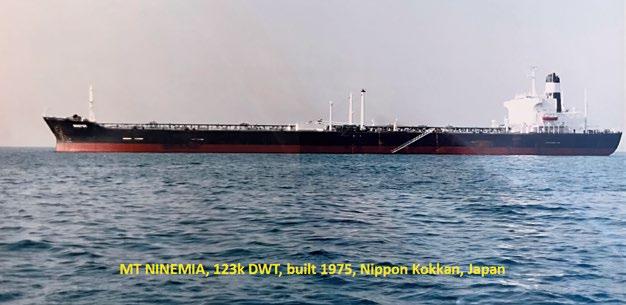
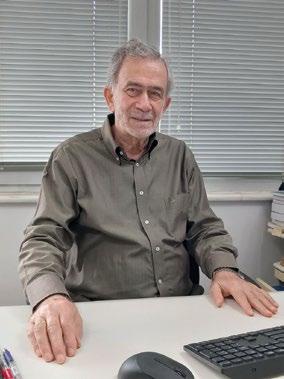
By Vaia Kyrodimou
Q1. How do you feel now that the Company has reached its 30th anniversary?
MM: “Very nice! At the beginning, there was anxiety and fear for the future. Now of course I am feeling satisfaction and pride.
Q2. How different is your job now from then?
MM: “It is extremely different! The technology has assisted our job. Especially telephones, internet and the progress of computers. In addition, the experience has as result to simplify the job and complete the tasks more quickly.”
Q3. How important is it to hire young people to take the Company forward?
MM: “It is highly significant to hire young people. The future belongs to the young generation. The oldest should support them in the highest level.”
These 30 years have been remarkable. Our ships have made almost 19,000 port calls and have delivered more than 630 million tons of cargo. Our fleet now stands at over 40 vessels and close to 4.8 million tons of deadweight. In 2023, we received delivery of the new suezmaxes, which were built at Samsung Heavy Industries. These ships boast the latest technological advances and have already joined our fleet. Today, our fleet consists of 41 quality vessels.
May the future be as productive and exciting as the last 30 years!

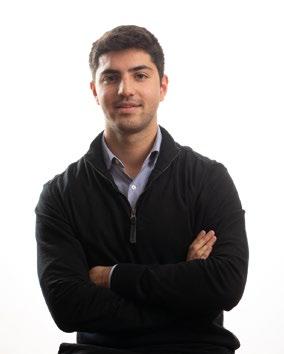
Q1. You carry the name of your late great uncle who was with the Company from when it was founded. Do you feel this creates a "burden" for you?
GS: “I do feel a sense of responsibility and a connection to my late great uncle who played a significant role in the Company's history. I am motivated to uphold the values and principles he stood for.
Carrying his name, does not feel like a "burden" for me, but a source of motivation and a reminder of the strong foundation on which the company was built.
I choose to see it as an opportunity to honor his achievements and contribute to the company's ongoing journey.”
Q2. If he were alive today he would be 84 years old - Which of the following do you think would surprise him most in terms of change: ship design, communications, the human element, Company culture or environmental regulations?
GS: “While all the aspects mentioned have experienced significant changes, he might be most surprised by the shift towards environmental regulations and sustainability, which stands out as one of the most notable developments with global implications and many effects on the industry.
Environmental regulations in the shipping industry have evolved significantly over the past 20 years, with a growing emphasis on sustainability and reducing the industry's environmental impact. Some key differences from when my late great uncle was active to the present is the implementation of ECA areas, Ballast Water Management regulations, Energy Efficiency Existing Ship Index (EEXI) etc.”
Q3. How do you feel as the youngest person in a Company with 120 people at Head Office?
GS: “In my opinion, age does not always correlate with competence or potential. Your value in a company is determined by your skills, contributions and ability to adapt and grow.
Being the youngest person in the office allows me to bring a new perspective and energy to the team while also learning from my experienced colleagues.
Younger employees may feel out of place at times due to generational differences in habits or interests, but everyone in this company has helped me become a member of the team and adjust to my new environment.
Also, a message I would like to convey to young people entering
Submitted by Panagiotis Bartzis

the workforce is that there is no need to act like you know everything. The best thing to do is to forget all about your pride, and learn as much as you can from your colleagues. People will appreciate your effort and you will develop yourself much faster than everybody else who is still worrying about what people think of them.”
Q4. What dreams and aims does a young person like you have in the shipping industry?
GS: “My career aspirations are centered on personal growth, making a positive impact by pursuing my passions and achieving a healthy work-life balance.
I believe in lifelong learning. I aspire to acquire new skills, expand my knowledge and stay updated on the latest industry trends so I can make an impact on the company.
When I retire, I want to look back on my career and be proud of what I have accomplished. I am excited to embark on this journey of continuous improvement.”
Q5. What do you imagine the Company will be like in 30 years' time?
GS: “It is challenging to predict with certainty what the Company will be like in 30 years, as many factors can influence its evolution. However, I believe that no matter the challenges that will arise over the next three decades, the Company will remain agile and adaptable embracing change and innovation, while staying true to its core values. I am envisioning a thriving organization and I have no doubt the Company will continue to operate like a family. For me, one of the most important aspects of the Company's success is the huge investment on the workforce, as well as and the positive office environment. There is a culture where all employees are respected and valued.
I am sure employee well-being will continue to be a top priority with continuous learning opportunities and a supportive environment to help the team members thrive in both their professional and personal lives.”
My journey at Centrofin started in 2006, when I joined M/T PANAGIA ARMATA as a Deck Cadet. It was the first time that I was about to travel abroad and I remember that I was anxious. I was lucky that Capt. Michail and the rest of the crew made my first experience on board exciting, and made me love the vessel and the sea. Although I was scheduled to sail on other vessels as well, it was my destiny to sail only on PANAGIA ARMATA six times. In 2013, an opportunity arose to join the team ashore, in the Crew Department. I gave it a lot of thought because I still wanted to sail onboard and gain more experience, but in the end, my curiosity won, and I decided to take the challenge and explore “the other side”. Looking back, I do not regret my decision; nevertheless, quite often I fondly remember the good old days.
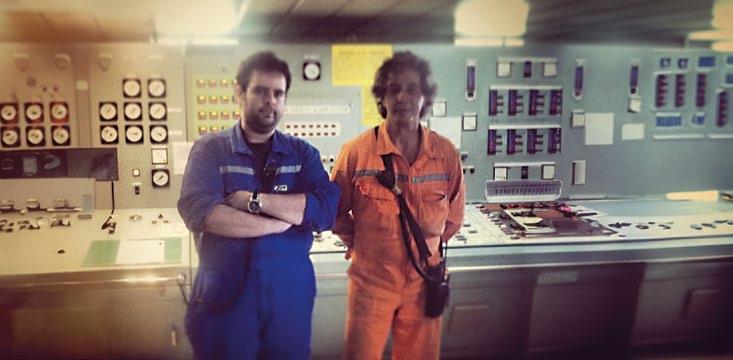
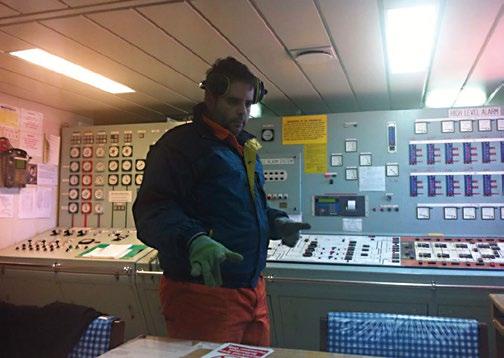
The call for the reduction of greenhouse gas emissions, especially that of carbon dioxide (CO2), to avert a major climate crisis has been sounding around the world for some time. Proposals regarding this reduction are mainly centered around the widespread use of clean energy like solar together with the phasing out of fossil fuels. While this strategy to reduce the amount of CO2 pumped into the atmosphere is theoretically sound, the likelihood of it replacing fossil fuels altogether in the near future is dubious due to a lack of infrastructure, scale and cost to name but three obstacles.
As a result, other methods of reducing the amount of CO2 in the atmosphere are being explored. One of these is carbon capture, which involves separating this greenhouse gas from other emitted substances at an industrial site and preventing it from reaching the atmosphere. Currently, four methods have been identified as being suitable to capture carbon dioxide. These are absorption (through the use of alkaline solutions), membrane separation (with polymeric membranes), absorption (on metal oxides, for example,) and chemical looping. Once the CO2 has been captured it is liquefied at a low temperature and high pressure.

make graphene, whose electrical properties make it a potential component in batteries and electronic devices. Additionally, it might be used to produce carbon nanotubes, which are stronger than steel yet lighter than aluminium.
The processes of capturing, storing and utilizing CO2 to lower
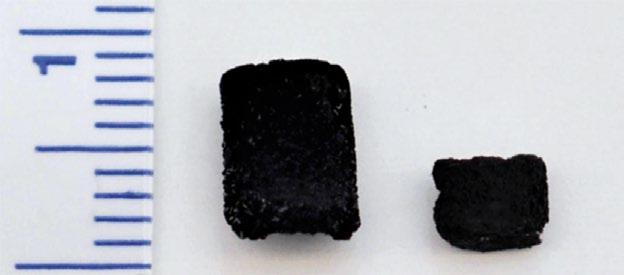
The next phase is to transport the CO2. In the case of Project Greensand, which has received widespread media attention, specially adapted vessels take purpose built containers containing the liquefied gas to a Danish section of the North Sea called the Nini West Field. The CO2 is then transferred to a sandstone reservoir about 5900ft (1800m) below the sea bed via newly constructed wells.
This project is expected to reach full scale in the first half of 2024 and will be able to store up to 1.5 million tonnes of the liquefied gas per year by 2026. It is estimated that this figure will rise to 8 million tonnes by 2030. The main aim of Project Greensand is to greatly reduce emissions in those industries that are the most difficult to decarbonize such as iron and steel, cement and chemical as well as large power plants.
Apart from playing a major role in the transportation of captured carbon, the maritime industry is examining ways of further reducing emissions on board vessels. More specifically, one of the projects under way is being conducted by Mitsubishi. This project is primarily concerned with the installation of the kinds of systems used for carbon capture in power plants on board vessels. The main aim is to reduce emissions by about 90%, and the outlook is positive as retrofitting such carbon capture systems on board can readily be compared to the successful fitting of scrubbers on board vessels.
On course, the implementation of carbon capture comes at a financial cost, so ways of utilizing the captured carbon dioxide are being explored. Some of these have already been established while others require research. For instance, it is known that CO2can be used in the manufacture of concrete to increase water resistance or in the production of urea, which is a major fertilizer. It can also be used in the beverage industry, the pharmaceutical industry, polymer synthesis and water treatment. As regards potential future uses, the captured carbon might be used to

greenhouse gas emissions is not meant to be a substitute for clean energy solutions. Instead, its function is to complement other methods like the adoption of solar energy installations and the preservation and augmentation of natural carbon sequesters such as mangroves and wetlands. Moreover, the creation of a value chain from utilizing captured carbon may well prove beneficial to the development of electronic components, new synthetics and fuels in the future.
Source: www.ise.ac.uk, www.en.wikipedia.org, www.projectgreensand.com www.ogci.com, www.safety4sea.com, www.iea.org, www.researchgate.net
In 1966, over 2000 years after Temasek (Singapore’s original name) became part of maritime trade networks, the Singapore Registry of Shipping (SRS) was established. Since then, the SRS has for the most part exhibited strong growth to earn a place among the world’s top registries. Internationally recognized as a top quality registry with one of the youngest quality fleets, the SRS is ranked number five by tonnage globally.
In terms of ownership, over 52% of the total tonnage of vessels registered with the SRS is Singaporean. In second place are Japanese-owned vessels, which account for 8% of the tonnage. Rounding out the top five are Chinese, Norwegian and Germanowned vessels with around 3-5% each.
The SRS has a very good safety record and is on both the Paris and Tokyo White Lists. Moreover, it is party to all the major IMO conventions on ship safety and marine pollution prevention. As regards its current strategies, one of the most important is its creation of a business-friendly environment, which appeals to ship owners worldwide.
Looking forward, the SRS has identified four major areas for development that will strengthen its position as a top registry. These are the smart and efficient use of technology, cyber resilience, crew welfare and the adoption of carbon-reducing solutions.
Situated at the southern tip of the Malay Peninsula, Singapore consists of just over 60 islands and islets that cover 281 square miles (729 sq.km). The largest island by far, Singapore Island, accounts for 94% of this area and is home to the vast majority of the country’s population of 5.8 million.

Marina Bay Sands at night from the Gardens. Source: en.wikipedia.org
Perhaps one of the most interesting aspects of this island is its architecture. The skyline is dominated by its tall buildings, five of which reach the height limit of 919ft (280m), and one, the Guoco Tower, which exceeds that by 13ft (4m) due to special permission having been granted. There are another 26 over 656ft (200m) and one of the most iconic, the three towers of the Marina Bay Sands, stands at 637ft (194m). In close proximity to many of these tall modern structures are much smaller traditional ones. Surprisingly, the newer and older buildings appear to complement each other.

Singapore is home to the largest port in South East Asia. It is also a place where high tech industries operate, banks ply their trade and business thrives. Recently, tourism has become more and more important to the economy following significant investment in hotels and shopping centres, and the development of recreational attractions.
Although the main island is the primary tourist attraction, there are other islands that are well worth a visit. One of the two other inhabited islands called Sentosa (pop. ~2000) at 1.8 sq. miles (4.7 sq. km) has a wide variety of fun activities on offer. Dubbed the ‘State of Fun’, Sentosa, which is just 0.25 miles (0.5 km) from Singapore Island, has a water park, a virtual roller coaster, a mega adventure park and four-dimensional immersive experiences to name but a few. For the more ‘adventurous’, there is Palau Ubin (pop. less than 100). This 3.9-square-mile (10.2km2) island caters for thousands of visitors annually. Camping facilities are available on the island as are boardwalk trails through the mangroves for those who wish to get close to the wildlife there.
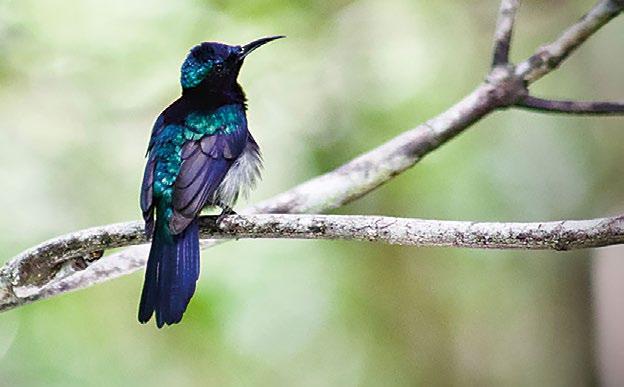
Some of the uninhabited islets such as Sungei Buloh, which is a wetland reserve, also have plenty to offer. This islet may only be 0.5 square miles (1.3 sq. km) in area, but it has many species of birds and reptiles for visitors to observe from its many hides. These species include the common greenshank, Eurasian whimbrel and curlew, which feed on an abundance of molluscs and worms, as well as the copper throated sunbird. Reptiles such as saltwater crocodiles, mangrove pit vipers and oriental whip snakes can also be seen.
As regards agriculture, there is little fertile soil so all the farming is intensive. All the produce is consumed locally, but Singapore is a major exporter of orchids and aquarium fish. The country also has a small aquaculture industry that produces sea bass, grouper and prawns.
Media representation of Singapore rightly focuses on the main island because of its vibrant culture, stunning architecture, maritime activities and much more. However, the other islands and islets have a lot to offer as well thanks to tourist attractions, conservation projects and nature education programs.
Sources: www.mpa.gov.sg, www.rivieramm.com, www.hbs.unctad.org, www.britannica.com, www.en.wikipedia.org
Ferdinand Magellan was born in 1480 to parents of the Portuguese nobility. Very little is known about his early life except that he was a page to Queen Leonor in Lisbon.
At the age of 25, he enlisted in the Portuguese Navy. More specifically, he joined a fleet commanded by Francisco de Almeida, who was the first Viceroy of Portuguese India. The main aim of the fleet’s voyage was to strengthen the country’s presence in the Indian Ocean. During this expedition, Magellan was wounded in an altercation at Cannanore (present-day Kannur) on India’s Malabar Coast.
During his early years at sea, he gained knowledge of navigation, which would serve him well. In 1506, he served under Nuna Vaz Pereira to Sofala on the Mozambique coast, where a Portuguese fort had been constructed. A year later he returned to India, where he was involved in a battle with the Malays in 1509. He exhibited heroism in the confrontation by saving the life of his friend Francisco Serrão.
Magellan remained in India until 1513, when he made his way back to Lisbon. Soon after, he was involved in a raid on the Moroccan-held town of Azamor (Azemmour). In the fighting he was wounded and he was left with a permanent limp. The Portuguese succeeded in plundering the Moroccan stronghold, but Magellan was accused of having behaved improperly after the battle. It was alleged that he had sold some of the spoils of war back to the Moroccans. It was an allegation that effectively ended his naval career in his home country. He was denied a request to lead a voyage to the Spice Islands by King Manuel, who told him to seek employment elsewhere.
So, in 1517, he went to Seville. There he met an influential Portuguese official called Diogo Barbosa, whose daughter he married. As Diogo Barbosa was well-connected, he was able to make the necessary introductions that would allow Magellan to arrange an appointment with King Charles I of Spain. He made a favourable impression and after pledging his allegiance to the King, he changed his name to Fernando de Magallanes from the Portuguese name of Fernão de Magalhães.
His first assignment with Rui Faleiro, a Portuguese cosmographer who had also offered his services to the Spanish King, was to confirm that the Spice Islands (Moluccas) were west of a line that separated the Portuguese territories to the east and those of Spain that lay to the west. There was significant opposition to the Spanish expedition being under the command of a Portuguese seafarer, so a Spanish co-commander was appointed. Additionally, Rui Faleiro withdrew due to ill health. In September 1519, Magellan’s flagship, Trinidad, set out with the San Antonio, Concepcion, Victoria and Santiago. Around 270 crewmembers were aboard the vessels. Most were either Spanish or Portuguese and tension was high between them despite the appointment of a Spanish co-commander.
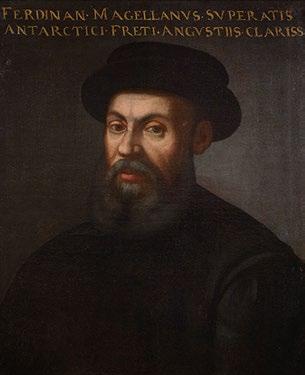

The first leg of the voyage was to Tenerife in the Canary Islands. Then, the fleet sailed to Rio de Janeiro and on to Port Saint Julia in Argentina, where they anchored in late March 1520. Prior to their departure Magellan had to quash a mutiny led by Spanish Captains. One of them was executed while another was left behind in Argentina.
After leaving on 24th August 1520, Magellan sailed south along the Santa Cruz River before he entered the strait he had been seeking. That strait now bears his name. Only the Trinidad, Concepcion and Victoria made it to the end of the strait and into the Pacific in November 1520.

By this time, the crews had begun to suffer. Scurvy was rife while thirst and hunger plagued them. Despite the adverse conditions on board, they exhibited resilience and drove themselves on. They crossed the Pacific and reached land in January 1521. They disembarked in Guam, where they got their first fresh food in more than three months. It was a very welcome change the rat-nibbled biscuits they had been surviving on!
At this point, Magellan was pretty sure he knew where the Moluccas where, so he headed towards the Philippines. On reaching the islands in March 1521, he was able to gain the first alliance for Spain in the Pacific. However, Ferdinand Magellan would never leave the Philippines. He was killed during conflict with indigenous peoples from Mactan Islands, who later became a symbol of resistance against the colonizers.
It may be argued that Ferdinand Magellan has not been given enough credit for his accomplishments as Portuguese historians have given more prominence to both Bartholomew Diaz and Vasco da Gama. Likewise, their Spanish counterparts have tended to focus more on the exploits of Cano. However, there can be no doubt that he was one of the greatest navigators of his age and that he was able to succeed against great odds. Indeed, his place as the first European to reach Asia via the Pacific has been compared those astronauts who have pioneered space exploration.
Source: www.history.com, www.britannica.com, www.en.wikipedia.org
DON’T LISTEN TO HIM. WE’RE TAKING YOU OVER THERE FOR A NICE CUP OF COFFEE. DON’T WORRY – YOU’RE IN SAFE HANDS.
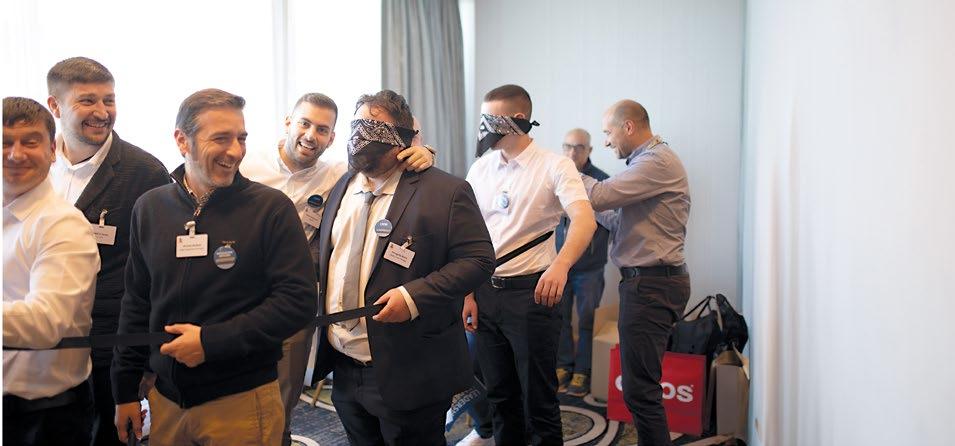
1. Make the names of two Company vessels using all the letters in the following sentence: I MEAN NO OPALS!
DO THEY KNOW WHERE YOU’RE TAKING THEM? DID YOU TELL THEM THE TRUTH?
2. The letters in the chemical symbols for calcium, phosphorus, silicon and sodium can be rearranged to form the name of a sea. . What is the name of the sea?
3. You can’t see us in your machinery, but we help preserve its finery. By reducing friction, we lower cost, and if you lose yours you will get lost. What are we?
4. Which four-letter word can be used to complete the following words? _ _ _ _ IAL, DE_ _ _ _URE, COM_ _ _ _MENT and S_ _ _ _ AN
5. Mark likes travelling. His favourite countries are Slovenia and South Korea, while his favourite capital cities are Oslo, Rome and Ottawa. He is a birder and the bird he likes best is the magpie. His favourite colours are violet and maroon. By the same token, which flavor does he prefer: strawberry or banana? Why?
6. Which four-letter word can be placed after the words to the left and before the words to the left?
GREEK - - - -DRILL CEASE BREAK FOREST HOSE
7. In 5 steps change the word WORK to REST by changing one letter at a time to form intermediate words.
6. Palak paneer is an Indian dish. Which ingredient of this dish appears in its name?
1. In which country is the port of Duqm located?
A. Yemen B. Oman C. Jordan D. Dubai
2. Which is the second most common cause of blackouts?
A. Control equipment failure B. Human error
C. Mechanical failure D. Main switchboard problems
3. Approximately what percentage of the world’s fresh surface water lies in the Great Lakes?
A. 8% B. 14% C. 20% D. 26%
4. What was the nationality of Abel Tasman?
A. Portuguese B. Spanish C. French D. Dutch
5. On which river are you most likely to see a felucca, a sailboat that has changed little in 1000 years?
A. Ganges B. Amazon C. Nile D. Po
A. spinach B. turmeric C. garlic D. coriander
7. Which famous vessel sank in Lake Superior on 10th November 1975?
A. SS Edmund Fitzgerald B. SS Hochelaga C. SS Arthur M. Anderson D. SS Andrea Doria
8. Which of the following gases is not included in the assessment of greenhouse gas emissions from marine fuels?
A. carbon dioxide B. methane C. nitrous oxide D. sulphur dioxide
9. In which country was the QE2 built in the 1960s?
A. Scotland B. Northern Ireland C. Wales D. England
10. The acronym EEXI is a technical measure to evaluate the energy efficiency of existing ships. What does the 'I' stand for?
A. Integer B. Indicator C. Information D. Index
8. What is the next number (X) in the following sequence? 0, 100, 19, 83, 24, 60, X TEST YOUR BRAIN answers:
Answers at the foot of the page Answers at the foot of the page

On21st December 2016 several fishermen set off from the southern Philippine port of General Santos on the Celebes Sea. Most of the fishermen were on board a large vessel, but 21-year-old Rolando Omongos and his 31-yearold uncle, Reniel Omongos, set sail on small boats.
On 10th January 2017 a storm hit the area where they were fishing. This resulted in Rolando and Reniel being separated from the mother boat. Rolando was on an eight-foot (2.5m) long boat and his uncle was on a second small boat. Neither of them had any food, extra fuel or fishing tackle, so when their fuel ran out on 15th January, they were in dire straits.
Five days after the storm began, their fuel ran out. At that point, they decided to throw their engines overboard so that their boats could float higher and would have a smaller chance of being flooded by large waves. Nephew and uncle adopted a chronic coping strategy, which entailed them drinking rainwater, eating moss that was growing on the hull of the eight-foot boat, and diving into the water regularly in order to keep cool and get respite from the tropical sun. After a month Reniel Omongos succumbed to his ordeal, and shortly afterwards, Rolando sank his small boat. After that the hunger an exposure that had led to his demise began to take a greater toll on Rolando.
Despite knowing how desperate his situation was and watching about four vessels pass by each day, Rolando never lost hope. He continued to drink rainwater, eat moss and prayed more frequently. Although he was able to stay positive, he could not avoid losing weight, which meant he could not escape the blazing sun due to his ever-weakening state.
On the 58th day of his nightmare, he managed to summon up enough strength to signal to a Japanese fishing vessel by waving his tattered shirt. This time the crew aboard the Wakaba Maru spotted him and headed towards his small craft. When they reached Mr. Omongos, he was in floods of tears. He was too weak to stand up, so he had to be carried aboard the Wakaba Maru. This was a simple task for the fishermen as the survivor had lost two thirds of his weight over the two-month period and was down to a little more than 20kg (44lbs). In short, he was emaciated.



Source: en.wikipedia.org
Following the rescue, Rolando was taken to Papua New Guinea. More specifically, he was dropped off at the island of New Britain, which is over 2000 miles (3200km) from his port of departure, General Santos. Three weeks after he was rescued, he was able to fly back to Manila.
After his first flight, he was greeted by family and reporters who wanted to find out more about Mr. Omongos. He revealed that his priority was to rest and think about going back to school as he had dropped out after sixth grade. He also stated that he would never again go to sea as a fisherman.
Sources: www.smh.com.au, www.theguardian.com, www.sgnews.yahoo.com